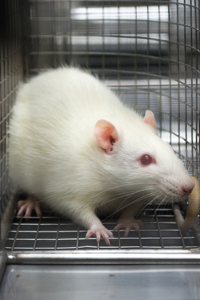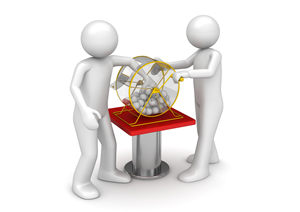Researchers have been testing individual chemicals in the environment for years to see if they can cause cancer, but this ignores the question of how low doses of chemicals that are considered safe, if tested separately, might cause cancer when mixed together. Well, an international research group of 174 scientists affiliated with leading research centers in 28 countries (no kidding, they’re all listed in the citation) just published the results of a study assessing the carcinogenic potential of low-dose exposures to chemical mixtures in the environment, and the results were not good.1 W. H. Goodson, L. Lowe, et al. “Assessing the carcinogenic potential of low-dose exposures to chemical mixtures in the environment: the challenge ahead.” Carcinogenesis (2015) 36 (Suppl 1): S254-S296. http://carcin.oxfordjournals.org/content/36/Suppl_1/S254.full In total, the researchers selected 85 examples of chemicals that are both unavoidable in the environment and that individually are not considered carcinogenic for review. The study found that cumulatively, they just might be. As the study concluded, “Our analysis suggests that the cumulative effects of individual (non-carcinogenic) chemicals acting on different pathways, and a variety of related systems, organs, tissues and cells could plausibly conspire to produce carcinogenic synergies.”
This research backs up the idea that chemicals not considered harmful by themselves are combining and accumulating in our bodies to trigger cancer and might lie behind the global cancer epidemic we are witnessing. In light of their analysis, the researchers called for rigorously pursuing additional research focused on the low-dose effects of chemical mixtures. This, at least from a medical perspective, is groundbreaking. And, as we will see, it “should” open the door to an entirely different way of looking at nutritional supplements and the testing of those supplements–but probably won’t.
How big a deal is this study? Current estimates from the World Health Organization suggest that the fraction of cancers attributable to toxic environmental exposures is between 7% and 19%, although, not surprisingly, scientists from within the chemical industry suggest the real numbers are somewhat less–probably closer to 5% or 10%. The study, however, found that the WHO estimate was right on the mark. Fifteen percent of the chemicals they looked at were found to have evidence of a dose-response threshold. But remember, that’s just looking at chemicals individually. What turned out to be astonishing to the researchers was that the study found that 59% of the chemicals they looked at (50 out of 85) exerted low-dose effects and were likely carcinogenic in combination with each other. Add those numbers together and you just went from chemicals in the environment causing 15% of all cancers to 74% (15-59)–a 400% increase.
 Generally, for chemical risk assessments, toxicity studies are conducted with individual chemicals in animal models with the objective of providing a dose-response assessment that estimates the quantity of substance above which adverse effects can be expected in humans. The no-observed-adverse-effect level is then used to establish safety criteria for human exposure. However, in order to be able to detect adverse effects, dose selection has historically involved the use of high dose levels. Statistical techniques are then used to predict safety margins for low-dose exposures. The problem with this model is that it does not allow for the possibility of synergistic interaction between and amongst low dose witches brew of individual chemicals in the environment. In other words, whereas the standard model for testing may find chemicals non-carcinogenic when looked at individually, those same chemicals may be capable of producing carcinogenic responses when combined with other chemicals also omnipresent in the environment–responses that are missed using current risk assessment practices.
Generally, for chemical risk assessments, toxicity studies are conducted with individual chemicals in animal models with the objective of providing a dose-response assessment that estimates the quantity of substance above which adverse effects can be expected in humans. The no-observed-adverse-effect level is then used to establish safety criteria for human exposure. However, in order to be able to detect adverse effects, dose selection has historically involved the use of high dose levels. Statistical techniques are then used to predict safety margins for low-dose exposures. The problem with this model is that it does not allow for the possibility of synergistic interaction between and amongst low dose witches brew of individual chemicals in the environment. In other words, whereas the standard model for testing may find chemicals non-carcinogenic when looked at individually, those same chemicals may be capable of producing carcinogenic responses when combined with other chemicals also omnipresent in the environment–responses that are missed using current risk assessment practices.
As William Goodson III, lead author of the report, said, “We’re swimming in this chemical soup … and we really don’t know what it’s doing to us. We’re pushing for the idea that the chemical testing has to basically go back to step one. Instead of looking at individual chemicals, look at chemicals in mixtures. We live in a mixture every day.”2 Rita Rubin, Michael W. Smith. “Can the ‘Chemical Soup’ We Live in Cause Cancer?” WebMD June 24, 2015. (Accessed 11 Jul 2015.) http://www.webmd.com/cancer/news/20150624/chemical-soup-cancer As Goodson told WebMD, “Probably the biggest thing I’ve done is stop drinking bottled water” because of the chemicals in the plastic bottles.” Still, he says, “if I go to a place where the only water available is bottled water, yes, I will drink it. I don’t have a choice.” Goodson says he’d prefer to buy milk in glass bottles, but it’s hard to find.
What’s in the Witches’ Brew?
But it’s not just water bottles and milk cartons. The problem is much, much bigger than that–exponentially bigger. So what chemicals are we talking about? Here’s just a sampling:
- Parabens are used in a wide variety of cosmetic products, including makeup, moisturizers, hair care products, deodorants, and shaving products. Typically, more than one paraben is used in a product, and they are often used in combination with other types of preservatives to provide preservation against a broad range of microorganisms. Parabens were specifically identified as problematic in the Goodson study.
- Phthalates are a group of chemicals used to soften and increase the flexibility of plastic and vinyl. They are used in hundreds of consumer products. They are also used in consumer products such as flexible plastic and vinyl toys, shower curtains, wallpaper, vinyl mini-blinds, food packaging, and plastic wrap. In addition, phthalates are used in wood finishes, detergents, adhesives, plastic plumbing pipes, lubricants, medical tubing and fluid bags, solvents, insecticides, medical devices, building materials, and vinyl flooring. And more disturbingly, they are used in cosmetics and personal care products, including perfume, hair spray, soap, shampoo, nail polish, and skin moisturizers–not to mention, school supplies.
- Fire retardants, including polybrominated diphenyl ethers. Although, beginning last year, suspect fire retardants are being phased out, they are likely to remain in the environment for years as manufacturers recycle them into different household products and as older furniture wends its way down into the homes of lower income families. And of course, these chemicals will continue to seep into our environment as they leach out of landfills.
- Non-stick cookware that contains perfluorooctanoic acid (PFOA).
- Pesticides.
- Petroleum based estrogens.
- Etc.
- Etc.
- Etc.
- And let’s not forget toxic heavy metals such as arsenic, lead, mercury, and cadmium that are in both our water supply and food chain–both as a result of industrial waste and their natural occurrence in nature.
And how much toxicity are we talking about? I hope you’re sitting down. Currently, there are over 84,000 chemicals registered for use with the U.S. Environmental Protection Agency. Keep in mind that being registered does not mean that they have been judged safe, only that they are used and tracked in some capacity. Currently, according to the World Wildlife Fund, only 14% of the chemicals used in the largest volumes have the minimum amount of data publicly available to make an initial basic safety assessment.3 “Toxic Chemicals.” WWF Global. (Accessed 11 Jul 2015.) http://wwf.panda.org/about_our_earth/teacher_resources/webfieldtrips/toxics/ Also, according to the WWF, between 1930 and 2000 global production of man-made chemicals increased from 1 million to 400 million metric tonnes each year.
Is this Study Really Groundbreaking?
Although it might seem obvious to any regular reader of this site that chemicals interact with each other in the human body so as to be more toxic in combination than individually, to the medical community…not so much. In fact, it goes against the very foundation of modern medicine. I covered this in detail in Lessons from the Miracle Doctors, but it’s worth reviewing.
 As Michael Culbert, in his book Medical Armageddon, describes it, modern medicine likes to claim Hippocrates and the ancient Greeks as its founding fathers, but the fact is that Isaac Newton and the seventeenth-century philosophers and scientists–who defined the universe as a giant machine ruled by the laws of mechanical physics and math–are probably much better candidates for the title.4 Culbert, Michael. Medical Armageddon. San Diego: C and C Communications,1994. Physicians of that era likewise began to define the human body as a machine that ran smoothly until acted upon by some outside agent (not entirely wrong, mind you). Accordingly, the human body could be studied, documented, medicated, and tweaked as required (not so correct). This viewpoint became more and more dominant as time went by, until by the nineteenth century:
As Michael Culbert, in his book Medical Armageddon, describes it, modern medicine likes to claim Hippocrates and the ancient Greeks as its founding fathers, but the fact is that Isaac Newton and the seventeenth-century philosophers and scientists–who defined the universe as a giant machine ruled by the laws of mechanical physics and math–are probably much better candidates for the title.4 Culbert, Michael. Medical Armageddon. San Diego: C and C Communications,1994. Physicians of that era likewise began to define the human body as a machine that ran smoothly until acted upon by some outside agent (not entirely wrong, mind you). Accordingly, the human body could be studied, documented, medicated, and tweaked as required (not so correct). This viewpoint became more and more dominant as time went by, until by the nineteenth century:
- The human body was no longer viewed as a holistic entity but rather as a grouping of separate parts and pieces.
- Disease was no longer viewed as an imbalance in the body but rather as a set of symptoms.
- Medical research was defined as the observation and classification of both the body’s parts and its various sets of symptoms.
Based on the above, the physician’s job was now defined as eliminating (or at least managing) those symptoms. In other words, disease or injury manifests as symptoms entirely separate from the body as a whole. Eliminate the symptoms, and you eliminate the problem.
As it turns out, this paradigm works extremely well when it comes to surgical repair. If you break an arm, the doctor works with that part of the body and repairs the arm. If you’re shot by a bullet, the doctor removes the bullet and repairs all of the separate parts of your body damaged by the bullet. It’s a direct one-to-one correlation. Unfortunately, the paradigm proves far less successful when it comes to many of our most feared degenerative diseases such as cancer.
As you can see, then, the idea of looking at toxins not as individual, separately acting entities but as part of an interactive, holistic, and toxic environment is indeed revolutionary for medical researchers. Yes, there have been some earlier cracks in the model, such as an acknowledgement that pharmaceutical drugs may interact with each other leading to unexpected side effects, but, at best, that’s still an emerging field. In other words, this new study really is groundbreaking within the medical community–but only within the medical community and the media that feeds off it.
Hardly a Breakthrough to the Alternative Health Community
What seems to have astounded the medical community is, in fact, accepted commonsense in the alternative health community. The idea that the body, the environment, and all foods and medications need to be viewed holistically is solidly engrained. In fact, holistic medicine is based on the concept. Let’s look at some examples of how this leads to a disconnect between the medical community and the natural health community.
Idiopathic Disease VS the Baseline of Health
 Idiopathic is a term doctors use to describe any disease for which they can’t identify a cause. Or more accurately, as Austin O’Malley and James Walsh said in their book Essays in Pastoral Medicine, “Idiopathic is a word we medical men use to conceal our ignorance of the cause of disease.”5 Austin O’Malley and James Walsh. Essays in Pastoral Medicine. New York. Longmans, Green and Co. 1906. But perhaps that inability to find a “cause” stems from the fact that, in many cases, there is no single cause. In fact, keeping in mind the “breakthrough” study, perhaps the disease is the result of a combination of factors. If true, then any single drug (or supplement, for that matter) is unlikely to do the trick. Instead, you need to address all of the causative factors all at once–you need to treat the body holistically. In Lessons from the Miracle Doctors, I called this the Baseline of Health® Program, and the fundamental principle of the program is to treat the body holistically. Do everything and do it all at once. First, clean out all toxins from every system in the body, then provide everything your body needs to rebuild itself.
Idiopathic is a term doctors use to describe any disease for which they can’t identify a cause. Or more accurately, as Austin O’Malley and James Walsh said in their book Essays in Pastoral Medicine, “Idiopathic is a word we medical men use to conceal our ignorance of the cause of disease.”5 Austin O’Malley and James Walsh. Essays in Pastoral Medicine. New York. Longmans, Green and Co. 1906. But perhaps that inability to find a “cause” stems from the fact that, in many cases, there is no single cause. In fact, keeping in mind the “breakthrough” study, perhaps the disease is the result of a combination of factors. If true, then any single drug (or supplement, for that matter) is unlikely to do the trick. Instead, you need to address all of the causative factors all at once–you need to treat the body holistically. In Lessons from the Miracle Doctors, I called this the Baseline of Health® Program, and the fundamental principle of the program is to treat the body holistically. Do everything and do it all at once. First, clean out all toxins from every system in the body, then provide everything your body needs to rebuild itself.
Since you don’t know everything affecting your body at any point in time, you’ve got to address all systems in your body all at once. You can’t look for magic bullets–if there were a magic bullet for what ails you, your doctor would have given it to you already. When using a holistic approach–unlike the medical approach–it doesn’t matter whether or not your disease is idiopathic. A holistic approach such as the Baseline of Health Program can actually eliminate the causes of many diseases, even if we don’t know exactly what those causes are! For example, it doesn’t matter what combination of toxins is causing disease in your body if you are purging every toxin from every major system in your body. It’s covered. Remember, your body is designed to be healthy. It has intelligent, built-in mechanisms to repair damage, optimize performance, and keep you going–provided you allow them to do their job.
Perhaps, someday, the medical profession could think more along these lines when dealing with idiopathic illness rather than continue to hunt for magic bullets. Or not…
Testing of Natural Healing Protocols
I’ve talked extensively about this a number of times over the years. Traditional medical studies are simply not designed to test the benefits of multi-part healing protocols. As we’ve already discussed, it goes against the fundamental paradigm of modern medicine. Medicine is “subtractive” by definition. All drug development, all drug patents, all efficacy testing are designed to reinforce this concept. By subtractive, I mean that all medicine is based on the idea that you need to “subtract” out anything that is irrelevant until you can isolate out the “one thing” left that “works.”

Everything in medicine is built around the “subtractive” concept. Drugs are developed using it. Patents are issued based on it. And all drug testing depends on it. But this is not the only way, nor necessarily the best way, to develop and test effective treatments–especially for diseases that might be caused by a mix of multiple toxins. Instead, you can try an “additive” approach. This is the approach used by most holistic treatments. Instead of using a single “drug,” most alternative therapies involve multi-part protocols (combining diet, supplements, cleanses, treatments, etc.). Alternative practitioners don’t care which component does what, or even if one or more of the components ultimately prove to be non-essential, as long as the overall protocol itself produces the desired result. This approach makes medical doctors apoplectic. For doctors, it doesn’t matter if an alternative protocol produces clear results. If you can’t isolate it down to a single component and explain exactly why it does what it does (in a way that fits within already defined scientific parameters), then “results be damned.” The therapy cannot work — even if the results indicate it does. This leads to some bizarre contradictions when it comes to testing alternative therapies.
And yet, this is exactly what doctors are now confronted with by the cancer study we’ve talked about today. The very essence of the study is that:
- You can’t always subtract diseases down to one single cause.
- You can’t always identify exactly why several components might cause a disease–only that they’re doing it.
The bottom line is that the study is indeed groundbreaking within the medical community. If it’s true–and time will prove that it is–it is paradigm shattering; but will it cause researchers to stop breaking down natural health protocols into individually testable components rather than testing the complete protocol?
Testing of Vitamins and Antioxidants as Complexes
This is something else we’ve explored repeatedly. Natural and synthetic vitamins are not the same thing. Synthetic vitamins are not only structurally different, they are removed from their natural complexes. Vitamin E is a good example. I won’t cover the structural differences now, other than to say that natural alpha tocopherol exists in only one form and bends light to the right whereas synthetic alpha-tocopherol contains seven additional forms and bends light to the left; this should provide a hint that something is different at the molecular level. However, we will address the issue of vitamin complexes since that goes to the heart of today’s discussion: that viewing things holistically matters.
When most people think of vitamin E, they think of alpha tocopherol–after all, that’s the chemical name listed on your vitamin bottle (sometimes as d-alpha tocopherol, the natural form, and sometimes as dl-alpha tocopherol, the synthetic form). But the truth is that vitamin E is not a single substance. It is actually a complex of at least eight compounds. There are four tocopherols and four tocotrienols that are all identified as having vitamin E activity. Specifically, these are:
- Alpha-tocopherol
- Beta-tocopherol
- Gamma-tocopherol
- Delta-tocopherol
- Alpha-tocotrienol
- Beta- tocotrienol
- Gamma- tocotrienol
- Delta- tocotrienol
 When you buy or test isolated alpha tocopherol (either synthetic or naturally derived), you’re not getting any of the other pieces of the vitamin E complex. Unfortunately, that’s a problem if you’re actually trying to evaluate the effectiveness of vitamin E. For example, studies have found that gamma-tocopherol may be more important, more essential even than alpha tocopherol. Gamma tocopherol plays an extremely important role defending against systemic inflammation caused by reactive nitrogen oxide compounds such as nitrogen dioxide and peroxynitrite–both of which are major components of automobile exhaust and cigarette smoke.6 Christen S, Jiang Q, Shigenaga MK, Ames BN. “Analysis of plasma tocopherols alpha, gamma, and 5-nitro-gamma in rats with inflammation by HPLC coulometric detection.” J Lipid Res. 2002 Nov;43(11):1978-85. http://www.jlr.org/content/43/11/1978.long Gamma-tocopherol may also protect against Alzheimer’s disease and prostate cancer.7 Jiang Q, Wong J, Ames BN. “Gamma-tocopherol induces apoptosis in androgen-responsive LNCaP prostate cancer cells via caspase-dependent and independent mechanisms.” Ann N Y Acad Sci. 2004 Dec;1031:399-400. http://www.ncbi.nlm.nih.gov/pubmed/15753180 , 8 Jiang Q, Wong J, Fyrst H, Saba JD, Ames BN. “gamma-Tocopherol or combinations of vitamin E forms induce cell death in human prostate cancer cells by interrupting sphingolipid synthesis.” Proc Natl Acad Sci U S A. 2004 Dec 21;101(51):17825-30. Epub 2004 Dec 13. http://www.ncbi.nlm.nih.gov/pubmed/15596715 In fact, there is the study that found that gamma-tocopherol inhibits cell proliferation and DNA synthesis in prostate cancer cells, whereas alpha-tocopherol does not.9 Gysin R, Azzi A, Visarius T. “Gamma-tocopherol inhibits human cancer cell cycle progression and cell proliferation by down-regulation of cyclins.” FASEB J. 2002 Dec;16(14):1952-4. http://www.fasebj.org/content/early/2002/12/02/fj.02-0362fje.long If you ignore the vitamin E complex in your testing, you lose all of these benefits in your results. How valid, then, are the results?
When you buy or test isolated alpha tocopherol (either synthetic or naturally derived), you’re not getting any of the other pieces of the vitamin E complex. Unfortunately, that’s a problem if you’re actually trying to evaluate the effectiveness of vitamin E. For example, studies have found that gamma-tocopherol may be more important, more essential even than alpha tocopherol. Gamma tocopherol plays an extremely important role defending against systemic inflammation caused by reactive nitrogen oxide compounds such as nitrogen dioxide and peroxynitrite–both of which are major components of automobile exhaust and cigarette smoke.6 Christen S, Jiang Q, Shigenaga MK, Ames BN. “Analysis of plasma tocopherols alpha, gamma, and 5-nitro-gamma in rats with inflammation by HPLC coulometric detection.” J Lipid Res. 2002 Nov;43(11):1978-85. http://www.jlr.org/content/43/11/1978.long Gamma-tocopherol may also protect against Alzheimer’s disease and prostate cancer.7 Jiang Q, Wong J, Ames BN. “Gamma-tocopherol induces apoptosis in androgen-responsive LNCaP prostate cancer cells via caspase-dependent and independent mechanisms.” Ann N Y Acad Sci. 2004 Dec;1031:399-400. http://www.ncbi.nlm.nih.gov/pubmed/15753180 , 8 Jiang Q, Wong J, Fyrst H, Saba JD, Ames BN. “gamma-Tocopherol or combinations of vitamin E forms induce cell death in human prostate cancer cells by interrupting sphingolipid synthesis.” Proc Natl Acad Sci U S A. 2004 Dec 21;101(51):17825-30. Epub 2004 Dec 13. http://www.ncbi.nlm.nih.gov/pubmed/15596715 In fact, there is the study that found that gamma-tocopherol inhibits cell proliferation and DNA synthesis in prostate cancer cells, whereas alpha-tocopherol does not.9 Gysin R, Azzi A, Visarius T. “Gamma-tocopherol inhibits human cancer cell cycle progression and cell proliferation by down-regulation of cyclins.” FASEB J. 2002 Dec;16(14):1952-4. http://www.fasebj.org/content/early/2002/12/02/fj.02-0362fje.long If you ignore the vitamin E complex in your testing, you lose all of these benefits in your results. How valid, then, are the results?
As for tocotrienols, which, as has already been mentioned, really are part of the vitamin E complex, there is abundant research that indicates that all four tocotrienols may be more important to your health and longevity10 Adachi H, Ishii N. “Effects of tocotrienols on life span and protein carbonylation in Caenorhabditis elegans.” J Gerontol A Biol Sci Med Sci. 2000 Jun;55(6):B280-5. http://www.ncbi.nlm.nih.gov/pubmed?term=10843344 than alpha-tocopherol–in fact, demonstrating 40-60 times the antioxidant activity.11 Serbinova E, Kagan V, Han D, Packer L. “Free radical recycling and intramembrane mobility in the antioxidant properties of alpha-tocopherol and alpha-tocotrienol.” Free Radic Biol Med. 1991;10(5):263-75. http://www.ncbi.nlm.nih.gov/pubmed/1649783
But most significant of all, studies now indicate that supplementing with high doses of isolated alpha-tocopherol may decrease the body’s ability to absorb gamma-tocopherol, while at the same time, reducing the effects of tocotrienols that you do absorb12 Handelman GJ, Machlin LJ, Fitch K, Weiter JJ, Dratz EA. “Oral alpha-tocopherol supplements decrease plasma gamma-tocopherol levels in humans.” J Nutr. 1985 Jun;115(6):807-13. http://www.ncbi.nlm.nih.gov/pubmed?term=3998871 – again, demonstrating the importance of supplementing with nutritional complexes in their natural ratios.
And it’s not just vitamin E. Beta carotene is always found in nature as part of a carotenoid complex and all of the B vitamins are found together in nature and vitamin C comes packaged with bioflavonoids and calcium. When you look at nature, everything comes in complexes. If you want to evaluate the true benefits of supplementing with vitamins and antioxidants, then you have to test supplements that maintain the integrity of those complexes.
Conclusion
The point is that the medical paradigm of looking at things in isolation–both in terms of diagnosing and testing–is catastrophically flawed. Yes, it works when the cause and the symptom are one and the same–the symptoms of a broken leg are directly connected to the break itself, for example, or the symptoms of a fever are connected to the infection that caused it. But the paradigm fails miserably when a particular disease or problem is caused, not by one thing, but by the interaction of several things such as a witches’ brew of chemicals in the environment. As the Goodson study showed, if you test each toxin by itself, you will find nothing. It’s only when you test them all together, and how they interact with each other, that you truly understand the cause behind the disease.
And just as the Goodson study found that you can’t ignore the importance of looking at the entire complex of chemicals found in our environment when looking for links to cancer, the obverse is also true when looking at natural treatments. You need to look holistically at nutritional supplements when studying their benefits. A nutrient that may not seem to provide any benefit on its own, might be incredibly important when considered in combination with the other nutrients normally found packaged with it in nature. And likewise, when testing the efficacy of natural health protocols, you need to test the benefits of the entire protocol before you begin testing the pieces. The question is: when will the medical community make such a leap? Unfortunately, considering how slowly they move, the answer is: probably not in my lifetime.

References
| ↑1 | W. H. Goodson, L. Lowe, et al. “Assessing the carcinogenic potential of low-dose exposures to chemical mixtures in the environment: the challenge ahead.” Carcinogenesis (2015) 36 (Suppl 1): S254-S296. http://carcin.oxfordjournals.org/content/36/Suppl_1/S254.full |
|---|---|
| ↑2 | Rita Rubin, Michael W. Smith. “Can the ‘Chemical Soup’ We Live in Cause Cancer?” WebMD June 24, 2015. (Accessed 11 Jul 2015.) http://www.webmd.com/cancer/news/20150624/chemical-soup-cancer |
| ↑3 | “Toxic Chemicals.” WWF Global. (Accessed 11 Jul 2015.) http://wwf.panda.org/about_our_earth/teacher_resources/webfieldtrips/toxics/ |
| ↑4 | Culbert, Michael. Medical Armageddon. San Diego: C and C Communications,1994. |
| ↑5 | Austin O’Malley and James Walsh. Essays in Pastoral Medicine. New York. Longmans, Green and Co. 1906. |
| ↑6 | Christen S, Jiang Q, Shigenaga MK, Ames BN. “Analysis of plasma tocopherols alpha, gamma, and 5-nitro-gamma in rats with inflammation by HPLC coulometric detection.” J Lipid Res. 2002 Nov;43(11):1978-85. http://www.jlr.org/content/43/11/1978.long |
| ↑7 | Jiang Q, Wong J, Ames BN. “Gamma-tocopherol induces apoptosis in androgen-responsive LNCaP prostate cancer cells via caspase-dependent and independent mechanisms.” Ann N Y Acad Sci. 2004 Dec;1031:399-400. http://www.ncbi.nlm.nih.gov/pubmed/15753180 |
| ↑8 | Jiang Q, Wong J, Fyrst H, Saba JD, Ames BN. “gamma-Tocopherol or combinations of vitamin E forms induce cell death in human prostate cancer cells by interrupting sphingolipid synthesis.” Proc Natl Acad Sci U S A. 2004 Dec 21;101(51):17825-30. Epub 2004 Dec 13. http://www.ncbi.nlm.nih.gov/pubmed/15596715 |
| ↑9 | Gysin R, Azzi A, Visarius T. “Gamma-tocopherol inhibits human cancer cell cycle progression and cell proliferation by down-regulation of cyclins.” FASEB J. 2002 Dec;16(14):1952-4. http://www.fasebj.org/content/early/2002/12/02/fj.02-0362fje.long |
| ↑10 | Adachi H, Ishii N. “Effects of tocotrienols on life span and protein carbonylation in Caenorhabditis elegans.” J Gerontol A Biol Sci Med Sci. 2000 Jun;55(6):B280-5. http://www.ncbi.nlm.nih.gov/pubmed?term=10843344 |
| ↑11 | Serbinova E, Kagan V, Han D, Packer L. “Free radical recycling and intramembrane mobility in the antioxidant properties of alpha-tocopherol and alpha-tocotrienol.” Free Radic Biol Med. 1991;10(5):263-75. http://www.ncbi.nlm.nih.gov/pubmed/1649783 |
| ↑12 | Handelman GJ, Machlin LJ, Fitch K, Weiter JJ, Dratz EA. “Oral alpha-tocopherol supplements decrease plasma gamma-tocopherol levels in humans.” J Nutr. 1985 Jun;115(6):807-13. http://www.ncbi.nlm.nih.gov/pubmed?term=3998871 |












A word of heartfelt thanks
A word of heartfelt thanks for all the research and thought that you put into each and everyone of your articles. You explain the science very well and you are very thorough when you rebut ideas that you disagree with. Please keep up the great work. I know it is time consuming so my thanks are very great.
Can you tell us where to get
Can you tell us where to get better vitamins we are at a loss
Have you seen this page?
Have you seen this page? http://www.jonbarron.org/dietary-supplement-recommendations
I take issue with your
I take issue with your statement that “if there were a magic bullet for what ails you, your doctor would have given it to you already.” I think that the FDA and big pharma would prevent that.
We appreciate the sentiment
We appreciate the sentiment behind your statement, but both the facts on the ground and the internal logic of the statement itself contradict it. Modern medicine has created thousands of magic bullets already—both surgical and pharmaceutical. The decline in infant mortality alone is monumental. In 1900, 30% of all children died before their first birthday. Today it’s about six percent. And as for pharmaceutical companies, they would be thrilled to discover AND patent a cure for a major disease. The amount of revenues they would receive for the life of the patent would be astronomical. Temporary, partial fixes, on the other hand, have to share revenues with competitors who develop a different partial fix. The problem with pharmaceutical companies, greed aside, is the very fact that they are obsessed with finding magic bullets because of the profits they would produce—but unfortunately, many diseases are holistic in nature and not amenable to magic bullet cures. Thus you end up with drugs that manage symptoms at the cost of major side effects.
Thank you Jon!
Thank you Jon!
I find this article to be a great introduction to the big picture regarding the mechanistic paradigm behind modern medicine and that people essentially “blind” themselves to the holistic nature of their life by conforming their understanding within that paradigm.
Without a truly holistic perspective (all-inclusive of body-mind-spirit) the individual may not fully appreciate that “Disease was no longer viewed as an imbalance in the body” (not to mention that the psyche deserves to be included in addition to “in the body”).
Much appreciate your reference that “Idiopathic is a word we medical men use to conceal our ignorance of the cause of disease.”!
The “… need to treat the body holistically.” depends on how you define holistic. Since the 80s I have defined holistic at least in terms of body-mind-spirit. This perspective is supported by the five biological laws of Dr. Hamer’s “new medicine” as well as by that of Anthroposophical medicine and other truly holistic approaches to medicine.
I’m curious Jon, has your program ever been evaluated in an independent review?
As Jon has explained, medical
As Jon has explained, medical researchers do not evaluate alternative health “protocols.” Their methodology pretty much demands that they test parts one at a time, separated out from the protocol. And since they don’t understand alternative health, they usually test those parts incorrectly as well.
This is absolutely a “dot
This is absolutely a “dot-connecting revelation”. Thanks for putting the effort you did in writing and explaining the details of the aggregate effects of our current environmental pollutants.
I do have one question that would require some additional research.
Of the compounds listed in the study, it is reasonable to assume that some will be absorbed into the body faster than others, likewise, some will have a greater staying power once inside the body when trying to flush them out.
Is it possible to discern in a table the absorption and purging of these compounds from the body? Also, it would be beneficial if we knew what the “half-life” of these compounds were since those with a higher number would be the ones we most likely would come in contact with.
Thanks very much
Don
. it sounds like Parabens may
. it sounds like Parabens may be xenoestrogens;
and that is possibly a source of cancer;
but, you say “Parabens were specifically identified
as problematic in the Goodson study”.
. I did a review of that paper at the link you gave
and couldn’t find mention of
any words containing the word fragment “paraben”;
. paraben seems mentioned only in a reference:
283
Janjua N.R. et al. (2007)
Systemic uptake of diethyl phthalate, dibutyl phthalate,
and butyl paraben
following whole-body topical application and
reproductive and thyroid hormone levels in humans.
Environ. Sci. Technol., 41, 5564–5570.
. and
that reference was used only here:
“Three other contenders were phthalates
(plasticizers that acted via three targets that included AhR,
steroid hormone receptors and PPAR) (282–285),”
—
. it appears they used that ref only for phthalates,
not for parabens.
. did I miss something?
As indicated in the first
As indicated in the first paragraph, the study itself only dealt with 85 chemicals—the tip of the iceberg, if you will. The second section of the newsletter (What’s in the Witches’ Brew) contains Jon’s observations as to how big the problem really is—upwards of 84,000 chemicals that have been released into the environment. Parabens were not singled out in the study; they were, however, singled out in Jon’s listing of some of the problematic groups within the larger scope of the 84,000 chemicals.